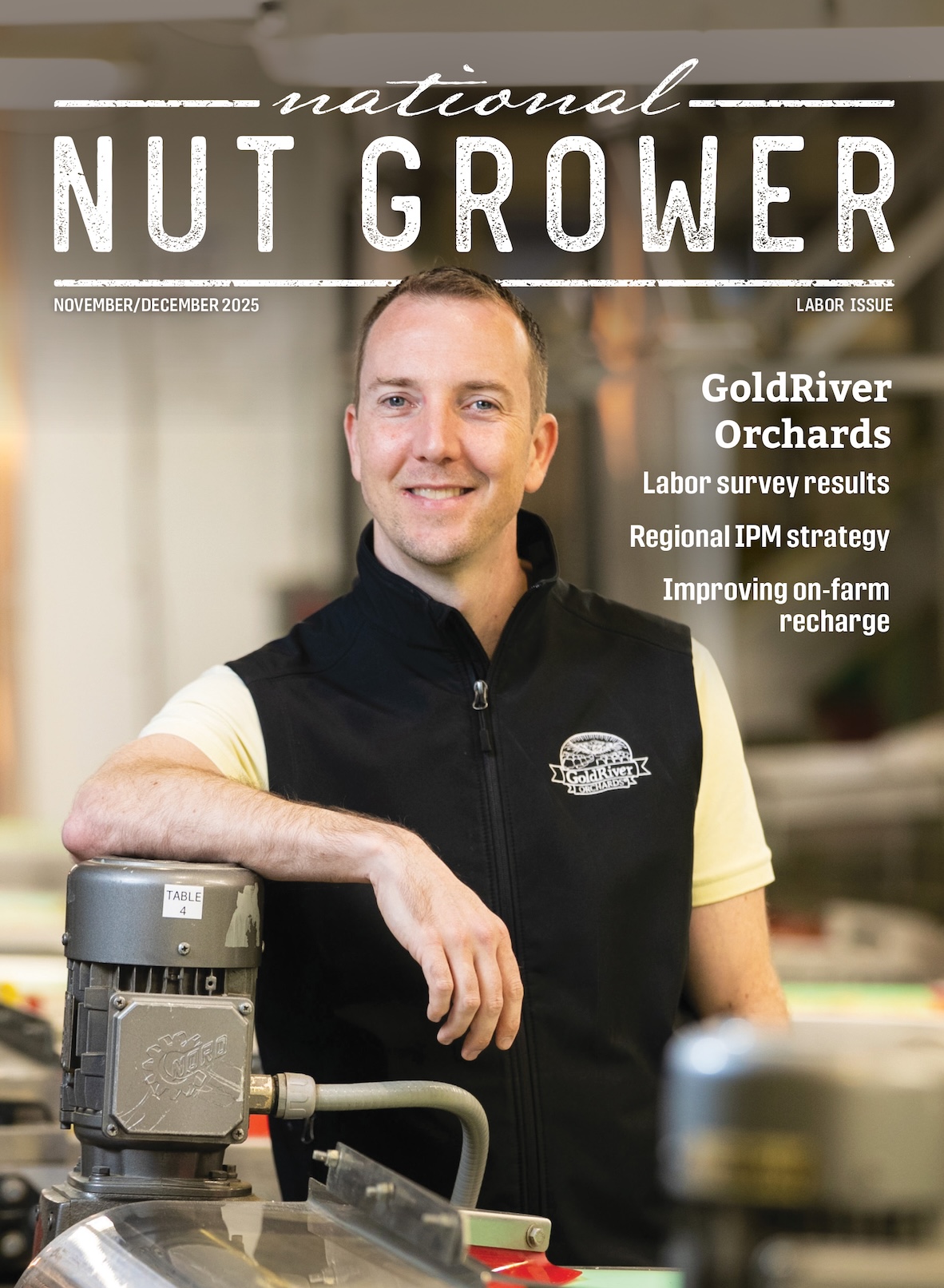
January/February 2025
Almonds 2025: Q&A with California Almond Board’s Clarice Turner
California almond growers have been shipping record-breaking volumes this season, following 2020’s record crop.
For the 2024-25 season, growers were expected to harvest more than 2.8 billion meat pounds, up from 2023-24’s 2.5 million meat pounds. More than 200 million pounds were shipped 11 months in a row last crop year, and more than 200 million pounds have already been shipped twice this crop year.
Additionally, more almonds were sold than were produced last crop year — the largest swing in the industry’s history — and carry out is now down to around 500 million, levels not seen since 2019.
Despite the high movement, almond farming remains challenging. Growers must deal with high input costs, pests and diseases, and export challenges.
To learn the latest in the almond industry, National Nut Grower met with Clarice Turner, president and CEO of the Almond Board of California (ABC). Based in Modesto, California, the ABC is a federal marketing order dedicated to promoting California almonds to domestic and international audiences through marketing efforts. The ABC also supports studies on almonds’ health benefits as well as modern agricultural practices to aid growers and further the industry’s environmental stewardship efforts.
How would you rate or evaluate the 2024 season?
Turner: I think it’s going to be a pretty good crop in terms of quality, and people seem to be pretty happy with it. The latest estimate was 2.8 billion pounds, and it was a decent harvest for the most part. In the South Valley, we had some pressure with a couple of heat events. So maybe we saw a little bit of effect there, but I think on balance throughout the entire state, the overall crop is looking as expected.
What do you think are the biggest challenges in the almond industry in 2025?
Turner: Some of the ones that have continued to plague us for the last couple of years, and that’s interest rates are still quite high. It’s the macroeconomic factors, the things we can’t control. We just have to deal with them as best we can and then input costs that are happening to make the orchard run. Also, things like nutrients. Those things are expensive and have been getting more expensive. At least we’ve been seeing a little bit of relief in the supply chain with transportation costs, but there are not very many places where you’ve seen prices go down.
What kinds of pests and disease challenges threaten growers?
Turner: Navel orange worm (NOW) and the Carpophilus beetle are the two biggest. There’s also red leaf blotch. We still have pest pressure with NOW, which we’ve been dealing with for 50 years. It’s not a new pressure, but it’s persistent. We know that if growers do proper sanitation, that’s the No. 1 thing because the NOW bugs overwinter in the mummy nuts. Most people are diligent about doing the sanitation.
The Almond Board has a lot of research against the NOW and we continue to try to figure out how to deal with that little guy, but it’s pretty pervasive. He just keeps resisting all the things we can come up with. We are also working on lots of different technologies to try to deal with the NOW.
The Carpophilus beetle is also a new one that’s come on the scene from Australia. We just published on our website what we’re recommending for that beetle, too.
We’ve got a lot of best practices out there about how to deal with the insects. Certainly, this crop year is looking better than last crop year with respect to pest pressure.
What other challenges are growers facing?
Turner: The macro ones are the hardest, because they’re unpredictable. Regulatory pressures are also difficult to deal with, whether coming from either the state or federal government. To some degree, trade is also challenging in terms of other countries’ regulatory issues.
How difficult is it today growing almonds compared to other years?
Turner: The pressures that have always been there have just gotten bigger. Inputs and interest rates have gone up. So, it’s kind of the same old things that have been pressuring the industry going into our 170th year of the commercial crop in the state of California. If you go back in the history books, they talk about the exact same struggles that growers are having now. It’s just that it’s intensified because everything sort of happened at once right after COVID. Remember when the port shut down and now all of a sudden your inventory is going nowhere.
It’s interesting because of the 7,600 California almond farms, 90% of them are family-owned and multi-generational, so they’re pretty resourceful and resilient. They’ve seen a lot in their lifetimes and certainly recent times have been very tough, but they know how to bob and weave. As one of them said to me, if you want to just be able to farm, it’s not for the faint of heart. And it’s been especially difficult these last three to four years. The growers have had to be very resourceful.
What are some of the major goals of the board going forward into the new year?
Turner: Driving global demand is job No. 1 for the Almond Board. The U.S., India and Western Europe are our biggest markets and where we’re focusing on driving incremental demand.
What we are focused on this year and in the coming years is innovation. I attended the food ingredients show. This whole plant-based protein isn’t going away. It’s moved from a trend to a mainstream marketplace. So, we could not be in a better place with the right product at the right time in having this nutritionally dense plant protein that is an almond.
So it’s a fantastic place to be. The other piece where we really are shifting gears is to be able to tell our environmental stewardship story, because we have a great story to tell. Our trees and the clean air of the state. Every year, almond growers’ trees are contributing to the state’s goal of being carbon neutral by 2045.
So far, the trees we have in the ground have already sequestered 33 million metric tons of carbon from the air. That’s all the passenger cars of California, Oregon, Washington and Texas combined. It’s a lot, and every year continues to contribute to capturing carbon from the air.
We also have four crops for every drop of water we are using, which we’re not getting credit for. We have a zero-waste industry. There’s a lot to be told there and, fortunately, we’ve been capturing farming data as part of our California Almond Stewardship Program for almost 20 years, so we have data to back it up and we’ve done the math. You will see a lot of environmental stewardship information starting to come from us. One of our goals is to tell that story and keep trying to innovate and get better and better as best we can.









